
GK Persei was a bright nova first observed on Earth in 1901. It was discovered by Thomas David Anderson, an Edinburgh clergyman, at 02:40 UT on 22 February 1901 when it was at magnitude 2.7. It reached a maximum magnitude of 0.2, the brightest nova of modern times until Nova Aquilae 1918. After fading into obscurity at about magnitude 12 to 13 during the early 20th century, GK Persei began displaying infrequent outbursts of 2 to 3 magnitudes. Since about 1980, these outbursts have become quite regular, typically lasting about two months and occurring about every three years. Thus, GK Persei seems to have changed from a classical nova like Nova Aquilae 1918 to something resembling a typical dwarf nova-type cataclysmic variable star.
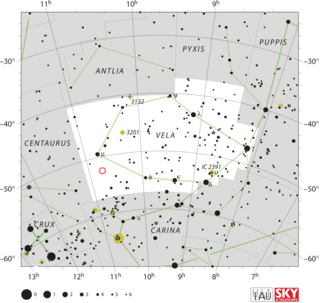
V382 Velorum, also known as Nova Velorum 1999, was a bright nova which occurred in 1999 in the southern constellation Vela. V382 Velorum reached a brightness of 2.6 magnitude, making it easily visible to the naked eye. It was discovered by Peter Williams of Heathcote, New South Wales, Australia at 09:30 UT on 22 May 1999. Later that same day it was discovered independently at 10:49 UT by Alan C. Gilmore at Mount John University Observatory in New Zealand.

T Aurigae was a nova, which lit up in the constellation Auriga in 1891. Thomas David Anderson, an amateur astronomer in Edinburgh, reported that he was "almost certain" he saw the nova at 02:00 UT on 24 January 1892, when it was slightly brighter than χ Aurigae. He mistook the star for 26 Aurigae, although he noted to himself that it seemed brighter than he remembered it being. He saw it twice more during the following week. On 31 January 1892 he realized his mistake, and wrote a note to Ralph Copeland reporting his discovery. Professor Copeland immediately reported the discovery via telegram to William Huggins, who made the first spectroscopic observations of T Aurigae on 2 February 1892, when the star was a magnitude 4.5 object. T Aurigae was the first nova to be observed spectroscopically.
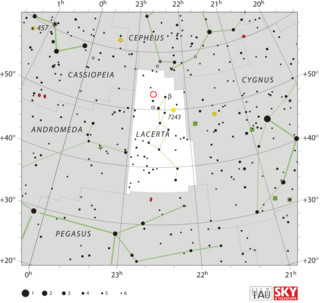
DI Lacertae or Nova Lacertae 1910 was a nova in constellation Lacerta which appeared in 1910. It was discovered by Thomas Henry Espinell Compton Espin at Wolsingham Observatory on 30 Dec 1910, at which time it was an 8th magnitude object. Subsequent examination of pre-discovery photographic plates showed that the outburst occurred sometime between 17 November 1910 and 23 November 1910. It reached a peak brightness of magnitude 4.6 on 26 November 1910, making it visible to the naked eye. Before the nova event DI Lacertae was a 14th magnitude star, and by 1950 it had returned to 14th magnitude.

CP Lacertae was a nova, which lit up on June 18, 1936 in the constellation Lacerta. It was discovered independently by several observers including Leslie Peltier in the US, E. Loreta in Italy, and Kazuaki Gomi, a Japanese barber who discovered the nova during the 19 June 1936 total solar eclipse.

BT Monocerotis was a nova, which lit up in the constellation Monoceros in 1939. It was discovered on a spectral plate by Fred L. Whipple on December 23, 1939. BT Monocerotis is believed to have reached mag 4.5, which would have made it visible to the naked eye, but that value is an extrapolation; the nova was not observed at peak brightness Its brightness decreased after the outbreak by 3 magnitudes in 182 days, making it a "slow nova". The light curve for the eruption had a long plateau period.

HR Lyrae or Nova Lyrae 1919 was a nova which occurred in the constellation Lyra in 1919. Its discovery was announced by Johanna C. Mackie on 6 December 1919. She discovered it while examining photographic plates taken at the Harvard College Observatory. The bulletin announcing the discovery states "Between December 4 and 6 it rose rapidly from the sixteenth magnitude or fainter, to a maximum of about 6.5". It was the first nova ever reported in Lyra, and Mackie was awarded the AAVSO gold medal for her discovery. Its peak magnitude of 6.5 implies that it might have been visible to the naked eye, under ideal conditions.
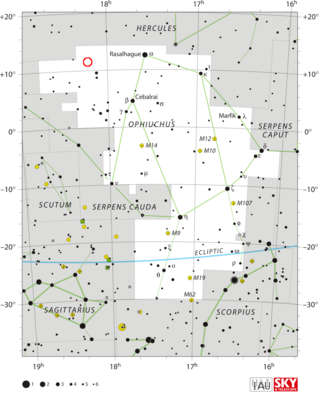
V849 Ophiuchi or Nova Ophiuchi 1919 was a nova that erupted in 1919, in the constellation Ophiuchus, and reached a blue band brightness of magnitude 7.2. Joanna C. S. Mackie discovered the star while she was examining Harvard College Observatory photographic plates. The earliest plate it was visible on was exposed on August 20, 1919, when the star was at magnitude 9.4. It reached magnitude 7.5 on September 13 of that year. In its quiescent state it has a visual magnitude of about 18.8. V849 Ophiuchi is classified as a "slow nova"; it took six months for it to fade by three magnitudes.

V604 Aquilae or Nova Aquilae 1905 is a nova which was first observed in the constellation Aquila in 1905 with a maximum brightness of magnitude 7.6. It was never bright enough to be seen with the naked eye. It was discovered by Williamina Fleming on a Harvard College Observatory photographic plate taken on August 31, 1905. Examination of plates taken earlier indicates that peak brightness occurred in mid-August 1905. The star's quiescent visual band brightness is 19.6.
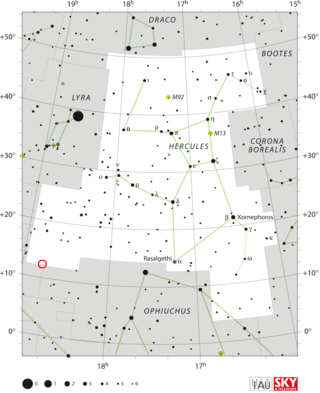
V838 Herculis, also known as Nova Herculis 1991, was a nova which occurred in the constellation Hercules in 1991. It was discovered by George Alcock of Yaxley, Cambridgeshire, England at 4:35 UT on the morning of 25 March 1991. He found it with 10×50 binoculars, and on that morning its apparent visual magnitude was 5. Palomar Sky Survey plates showed that before the outburst, the star was at photographic magnitude 20.6 and 18.25.
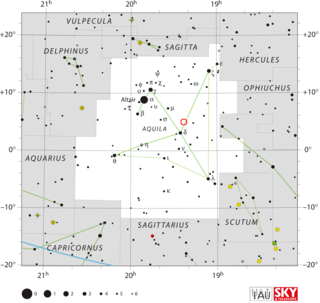
V1494 Aquilae or Nova Aquilae 1999 b was a nova which occurred during 1999 in the constellation Aquila and reached a brightness of magnitude 3.9 on 2 December 1999. making it easily visible to the naked eye. The nova was discovered with 14×100 binoculars by Alfredo Pereira of Cabo da Roca, Portugal at 18:50 UT on 1 December 1999, when it had a visual magnitude of 6.0.
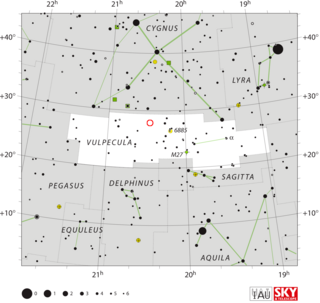
QU Vulpeculae, also known as Nova Vulpeculae 1984 Number 2, was the second nova which occurred in 1984 in the constellation Vulpecula. It was discovered by Peter Collins, an amateur astronomer from Cardiff, California at 22:08 UT on 22 December 1984. At the time of its discovery, the nova's apparent magnitude was 6.8. By the next night, Collins reported its brightness had increased to magnitude 5.6, making it visible to the naked eye.
45 Aquilae, abbreviated 45 Aql, is a triple star system in the equatorial constellation of Aquila. 45 Aquilae is its Flamsteed designation. It is located 350 light-years away from Earth, give or take a 6 light-year margin of error, and has a combined apparent visual magnitude of 5.7. The system is moving closer to the Earth with a heliocentric radial velocity of -46 km/s.

RW Ursae Minoris is a cataclysmic variable star system that flared up as a nova in the constellation Ursa Minor in 1956.

V1315 Aquilae is a cataclysmic variable star in the north of the equatorial constellation of Aquila. It is in the sub-set of nova-like (NL) variables, specifically a SW Sextantis star. These were characterized as having non-magnetic white dwarfs – thus that do not undergo dwarf-nova bright luminations ("eruptions"). There is countering evidence for some magnetism. Being a SW Sextantis star, V1315 Aquilae has a high rate of mass transfer, so it is in steady-state accretion and in a constant state of outburst. It emits most of its light in the visible range, and this comes from the accretion disk. The eclipse depth is 1.8 mag. No description of the donor star is made.
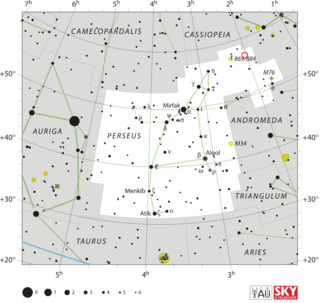
V Persei, also known as Nova Persei 1887 was discovered by Williamina Fleming on a Harvard College Observatory objective-prism photograph taken on 3 November 1887. It is believed to be the first nova whose spectrum was recorded. The nova had an apparent magnitude of 9.2 at the time of discovery. Judging from the consistency of the nova's brightness after discovery, and details of the spectral lines seen, McLaughlin estimated that the nova was five or six months past peak brightness at the time of its discovery, and at its peak it was almost certainly at least as bright as 4th magnitude. So V Persei was probably visible to the naked eye, though there is no record that anyone actually noticed it when that was possible. It is currently an 18th magnitude object.
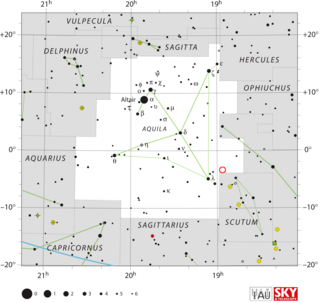
EL Aquilae, also known as Nova Aquilae 1927 was a nova that appeared in 1927. It was discovered by Max Wolf on photographic plates taken at Heidelberg Observatory on 30 and 31 July 1927 when it had a photographic magnitude of 9. Subsequent searches of plates taken at the Harvard College Observatory showed the nova was fainter than magnitude 11.1 on 8 June 1927 and had flared to magnitude 6.4 on 15 June 1927. It declined from peak brightness at an average rate of 0.105 magnitudes per day, making it a fast nova, and ultimately dimmed to about magnitude 21. The 14.5 magnitude change from peak brightness to quiescence was unusually large for a nova.

QZ Aurigae, also known as Nova Aurigae 1964, was a nova which occurred in the constellation Auriga during 1964. It was discovered by Nicholas Sanduleak on an objective prism photographic plate taken at the Warner and Swasey Observatory on 4 November 1964. Examination of pre-discovery plates from Sonneberg Observatory showed that the eruption occurred in early February 1964, and it had a photographic magnitude of 6.0 on 14 February 1964. Its brightness declined in images taken after the 14th, suggesting that its peak brightness was above 6.0. It was probably visible to the naked eye for a short time.
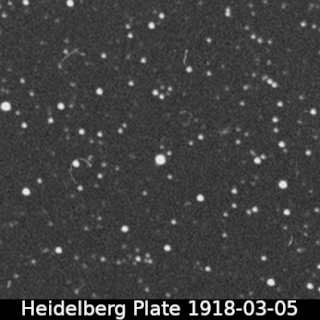
GI Monocerotis, also known as Nova Monocerotis 1918, was a nova that erupted in the constellation Monoceros during 1918. It was discovered by Max Wolf on a photographic plate taken at the Heidelberg Observatory on 4 February 1918. At the time of its discovery, it had a photographic magnitude of 8.5, and had already passed its peak brightness. A search of plates taken at the Harvard College Observatory showed that it had a photographic magnitude of 5.4 on 1 January 1918, so it would have been visible to the naked eye around that time. By March 1918 it had dropped to ninth or tenth magnitude. By November 1920 it was a little fainter than 15th magnitude.

V1370 Aquilae, also known as Nova Aquilae 1982, is a nova that appeared in the constellation Aquila during 1982. It was discovered by Minoru Honda of Kurashiki, Japan at 20:30 UT on 27 January 1982. At that time the Sun had moved just far enough from Aquila to allow the nova to be seen in the morning sky. Although it was discovered photographically, its apparent magnitude was 6–7, making it potentially visible to the naked eye under ideal conditions. A possible magnitude 20 progenitor was located on the Palomar Sky Survey prints. Spectra of the object were taken in February 1982 at Asiago Astrophysical Observatory, which confirmed that it is a nova.




















